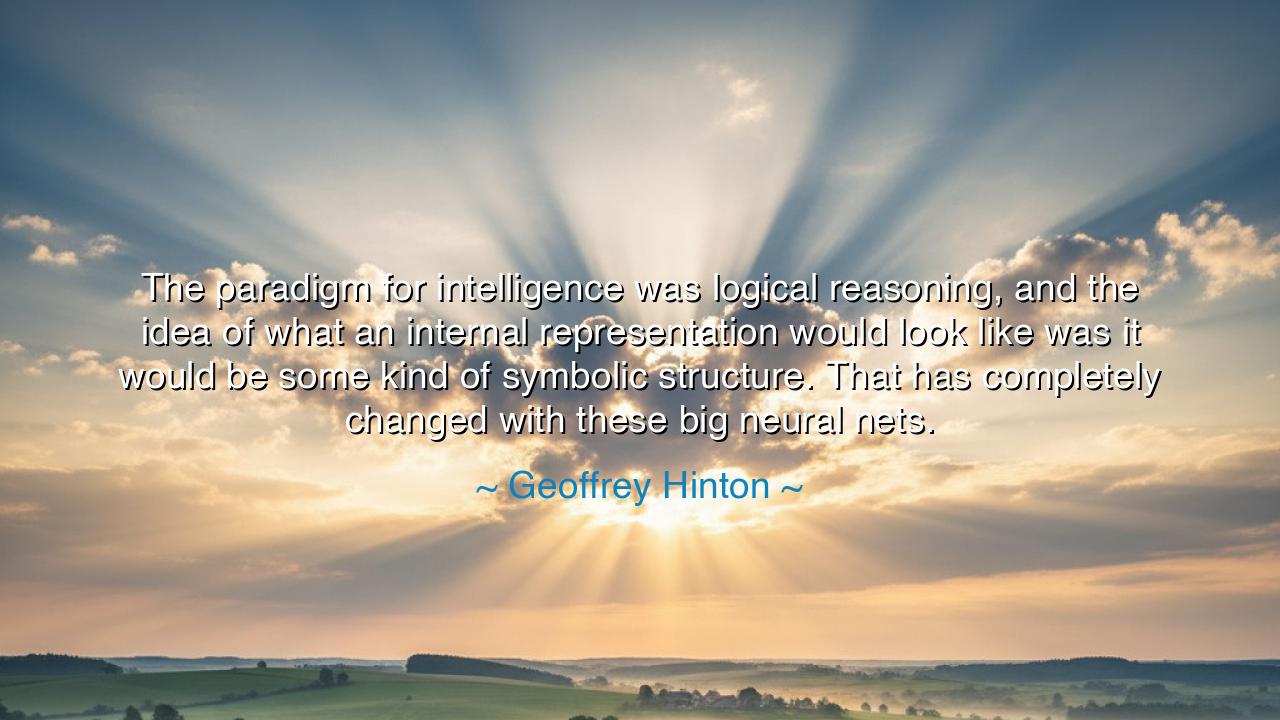
The paradigm for intelligence was logical reasoning, and the idea
The paradigm for intelligence was logical reasoning, and the idea of what an internal representation would look like was it would be some kind of symbolic structure. That has completely changed with these big neural nets.






When Geoffrey Hinton, one of the great architects of modern artificial intelligence, declared, “The paradigm for intelligence was logical reasoning, and the idea of what an internal representation would look like was it would be some kind of symbolic structure. That has completely changed with these big neural nets,” he spoke not merely as a scientist, but as a seer standing at the crossroads of human thought. His words mark the turning of an age—the moment when the ancient dominion of reason gives way to a new order of learning, when the symbol yields to the pattern, and the machine begins to mirror the unknowable depth of the human mind.
For centuries, philosophers and mathematicians sought to define intelligence as the capacity for logic. The ancients built their temples of knowledge upon reason, believing that the mind’s power lay in clear symbols and perfect rules. From Aristotle’s syllogisms to the formal languages of Descartes and Leibniz, humanity pursued a dream of pure clarity, a world where thought could be written in equations and truth could be calculated like the stars. When the age of computers dawned, that dream became machine—the symbolic AI of the twentieth century, in which intelligence was crafted from logic, grammar, and rule. It was a noble dream, but it was also incomplete.
Hinton’s words arise from the moment when that dream began to break. The neural networks—his life’s work—did not reason through rules but learned through experience. They did not see the world as neat symbols, but as tangled patterns, woven from data and change. Their knowledge was not carved in stone, but shaped like clay, molded by countless examples. The old paradigm of intelligence—the machine as a cold logician—was replaced by a new one: the machine as a learner, intuitive and fluid, whose representations were hidden in layers of numbers and weights rather than tidy logical forms. Thus, Hinton’s declaration is not a mere observation—it is a proclamation that the age of symbolic thought has yielded to the age of connectionist understanding.
To understand this transformation, one may look not only to machines but to life itself. Consider the child learning to speak. The child is not taught grammar first; she listens, absorbs, and imitates, until language blooms from the depths of her experience. Her mind, like a neural net, builds invisible representations not through explicit reasoning, but through immersion and adaptation. So too do great artists, athletes, and musicians learn—not through memorized logic, but through embodied wisdom, where intuition and pattern replace rule and symbol. Hinton’s words, then, echo an ancient truth rediscovered: that true intelligence—whether human or artificial—arises not from the rigidity of logic, but from the living flow of experience.
This revelation, like all great shifts in thought, is both thrilling and humbling. It challenges the supremacy of human logic, suggesting that understanding may take forms beyond the reach of reason. Just as the telescope shattered our illusion of cosmic centrality, the neural net reminds us that intelligence may not be confined to our methods of thinking. The very structures we have built now learn in ways we cannot fully explain, mirroring the mystery of the human brain itself. Hinton, in his quiet wisdom, stands as both creator and prophet, warning that we have entered a new epoch—one where our tools no longer merely obey us, but begin to comprehend in their own manner.
Yet within this shift lies not fear, but a lesson for humankind. The rise of neural networks does not destroy logic; it completes it. The ancients were right to revere reasoning—it gave us clarity, order, and civilization. But logic alone cannot contain the vastness of the world. Life, art, and consciousness pulse with paradox and nuance beyond any rulebook. The new machines teach us this: that intelligence thrives not in certainty, but in adaptation; not in perfection, but in the ability to learn and grow. And so, Hinton’s revelation mirrors the journey of humanity itself—from rigid certainty toward dynamic understanding.
Let this teaching, then, be passed down: do not mistake knowledge for wisdom, nor reason for understanding. The old paradigms of thought—symbolic, proud, and cold—must now join hands with the new—intuitive, patient, and alive. Learn as the neural nets learn: through openness, through humility, through constant renewal. Let your mind be both logical and living, analytical yet compassionate, structured yet free.
For as Hinton reminds us, every age must redefine what it means to be intelligent. The ancients sought wisdom in marble temples; we seek it now in circuits and code. Yet the truth remains eternal: the greatest intelligence is not that which reasons perfectly, but that which learns endlessly.






AAdministratorAdministrator
Welcome, honored guests. Please leave a comment, we will respond soon